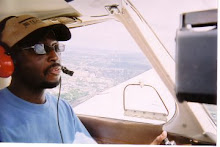The first thing you need to keep in mind is that I have not flown since October, which was about nine months ago. So you know how excited I was to get back in the air after this extended period with my feet, sadly, planted on the ground.
My plane, 94400, was in the air when I arrived at the airport. And as I anticipated it needed to be fueled up after the previous student was done with his lesson. While standing by the airplane talking to the student while he was tying down, my flight instructor Mark yelled across the apron "How much hood time have you gotten so far?". I don't think he was asking me how much time I had spent in "The Hood", so the answer was zero time.
After going through the usual re-acquaintance of the airplane we were up in the air for about five minutes, not even giving me a chance to practice any turns or any other maneuvers he had put on the hood and we started boring holes in the sky with my head buried in the panel. This is where my experience with Microsoft Flight Simulator started to pay off. Keeping in mind that I was rusty for not flying all this time overall I did pretty well and was not intimidated too much, except when Mark decided to cover up the heading indicator. When Mark tried to show me how to turn to headings based on timing my turns it started to become a little overwhelming, but I was still somewhat successful. Mark also had me hold my head down and asked me to fly in different attitudes without looking at the instruments. It pretty much was a head down do not look at the panel, turn left without looking at the panel and then start to climb without looking at the panel, and then he would remove the hood and I would have to recover from these unusual attitudes. From this, I began to appreciate the need for an instrument rating and why it is very important to stay out of the clouds and what could happen if you had a partial panel when flying into clouds. We finished up with me flying to Wayne County under the hood with him talking me through the approach and then removing my lead when about 200 feet off of the ground on very short final.
We flew back to the home base in my landing actually was not bad after not flying for such a long time. What made this landing better than all of the others was that might push the was right on target, at 60 knots, and there is very little float when I flared for landing.
I decided to take an hour and a half break while Mark flew with another student and then decided to go up for some takeoffs and landings. For some reason the airplane did not want to make its descent steep enough and I ended up with three aborted landings. Now keep in mind this, I have probably aborted three landings in all of my training but today I had three in one hour. All of the landings were aborted because I was high on my approach after I turned final. Mark suggested that I would slip and lose altitude on final approach, but I felt uneasy about that because I had not performed a slip let's just say for a very very long time. So we departed the pattern and flew out to a practice area and practice a couple slips, and came back for a few more landings. After a couple of mediocre and hot landings I decided to call it a day. Even though I wanted to try a couple more landings I had to call it a day mostly due to the fact that I had consumed two large bottles of water and when you have three kidneys that water gets processed very quickly and you know what happens after that.
Next weekend is the Poker Run between four airports, and since I am due for my dual cross country this would be a great time to get it in a 200 mile, four hour cross-country instruction. We will see.

